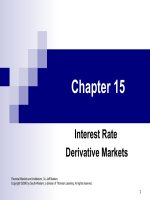Thị trường tài chính và các định chế tài chính_ Chapter 10
Bạn đang xem bản rút gọn của tài liệu. Xem và tải ngay bản đầy đủ của tài liệu tại đây (153.56 KB, 47 trang )
1
Chapter 10
Stock Offerings and
Investor Monitoring
Financial Markets and Institutions, 7e, Jeff Madura
Copyright ©2006 by South-Western, a division of Thomson Learning. All rights reserved.
2
Chapter Outline
Background on stock
Initial public offerings
Secondary stock offerings
Stock exchanges
Investor participation in the secondary market
Monitoring by investors
The corporate monitoring role
Globalization of stock markets
3
Background on Stocks
A stock is a certificate representing partial ownership in a
corporation
Stock is issued by firms to obtain long-term funds
Owners of stock:
Can benefit from the growth in the value of the firm
Are susceptible to large losses
Individuals and financial institutions are common purchasers of
stock
The primary market enables corporations to issue new stock
The secondary market creates liquidity for investors who invest in
stock
Some corporations distribute earnings to investors in the form of
dividends
4
Background on Stocks (cont’d)
Ownership and voting rights
The owners are permitted to vote on key matters
concerning the firm:
Election of the board of directors
Authorization to issue new shares
Approval of amendments to the corporate charter
Adoption of bylaws
Voting is often accomplished by proxy
Management typically receives the majority of the
votes and can elect its own candidates as directors
5
Background on Stocks (cont’d)
Preferred stock
Preferred stock represents an equity interest in a firm that
usually does not allow for significant voting rights
A cumulative provision on most preferred stock prevents
dividends from being paid on common stock until all preferred
dividends have been paid
Preferred stock is less risky because dividends on preferred
stock can be omitted
Preferred stock is a less desirable source of funds than bonds
because:
Dividends are not tax deductible
Investors must be enticed to purchase the preferred stock since
dividends do not legally have to be paid
6
Background on Stocks (cont’d)
Issuer participation in stock markets
The ownership feature attracts many investors who
want to have an equity interest but do not necessarily
want to manage their own firm
A firm issuing stock for the first time engages in an
IPO
If a firm issues additional stock after the IPO, it
engages in a secondary offering
7
Initial Public Offerings
An IPO is a first-time offering of shares by a
specific firm to the public
Usually, a growing firm first obtains private
equity funding from VC firms
An IPO is used to obtain new funding and to
offer VC firms a way to cash in their investment
Many VC firms sell their shares in the secondary
market between 6 and 24 months after the IPO
8
Initial Public Offerings (cont’d)
Process of going public
An investment banking firm normally serves as the lead
underwriter for the IPO
Developing a prospectus
The issuing firm develops a prospectus and files it with the SEC
The prospectus contains detailed information about the firm and
includes financial statements and a discussion of risks
The prospectus is intended to provide investors with the
information they need to decide whether to invest in the firm
Once approved by the SEC, the prospectus is sent to institutional
investors
Underwriters and managers meet with institutional investors in the
form of a “road show”
9
Initial Public Offerings (cont’d)
Process of going public (cont’d)
Pricing
The offer price is determined by the lead underwriter
During the road show, the number of shares demanded at
various prices is assessed
Bookbuilding
In some countries, an auction process is used for IPOs
Transaction costs
The issuing firm typically pays 7 percent of the funds
raised
The lead underwriter typically forms a syndicate with other
firms who receive a portion of the transaction costs
10
Initial Public Offerings (cont’d)
Underwriter efforts to ensure price stability
The lead underwriter’s performance can be measured by the
movement in the IPO shares following the IPO
If stocks placed by a securities firm perform poorly, investors may
no longer purchase shares underwritten by that firm
The underwriter may require a lockup provision
Prevents the original owners from selling shares for a specified
period
Prevents downward pressure
When the lockup period expires, the share price commonly
declines significantly
11
Initial Public Offerings (cont’d)
Timing of IPOs
IPOs tend to occur more frequently during bullish stock
markets
Prices are typically higher
In the 2000–2001 period, many firms withdrew their IPO plans
Initial returns of IPOs
First-day return averaged about 20 percent over the last 30 years
In 1998, the mean one-day return for Internet stocks was 84
percent
Most IPO shares are offered to institutional investors
About 2 percent of IPO shares are offered as allotments to
brokerage firms
12
Initial Public Offerings (cont’d)
Abuses in the IPO market
In 2003, regulators attempted to impose new
guidelines that would prevent abuses
Spinning is the process in which an investment bank
allocated IPO shares to executives requiring the help of an
investment bank
Laddering involves increasing the price above the offer
price on the first day of issue in response to substantial
demand
Excessive commissions are sometimes charged by
brokers when there is substantial demand for the IPO
13
Initial Public Offerings (cont’d)
Long-term performance following IPOs
IPOs perform poorly on average over a period of a
year or longer
Many IPOs are overpriced at the time of issue
Investors may be overly optimistic about the firm
Managers may spend excessively and be less efficient with
the firm’s funds than they were before the IPO
14
Secondary Stock Offerings
A secondary stock offering is:
A new stock offering by a firm whose stock is already publicly
traded
Undertaken to raise more equity to expand operations
Usually facilitated by a securities firm
In the late 1990s, the volume of publicly placed stock
increased substantially
From 2000 to 2002, the volume of publicly placed stock
declined as a result of the weak economy
Existing shareholders often have the preemptive right to
purchase newly-issued stock
15
Secondary Stock Offerings (cont’d)
Shelf-registration
A corporation can fulfill SEC requirements up to two
years before issuing new securities
Allows firms quick access to funds
Potential purchasers must realize that information
disclosed in the registration is not continually updated
16
Stock Exchanges
Stock trading between investors occurs on an
organized stock exchange or on the over-the-
counter (OTC) market
Organized exchanges
Includes the NYSE and AMEX
The NYSE controls 80 percent of the value of all
organized exchange transactions
There are 1,366 seats
Floor brokers and specialists are members of the NYSE
17
Stock Exchanges (cont’d)
Organized exchanges (cont’d)
Trading floor
Consists of trading posts and trading booths
20 trading posts are maintained by specialists and their clerks
There are 1,500 trading booths along the perimeter of the floor
where brokers obtain orders
Listing requirements
NYSE requirements include number of shares outstanding,
minimum level of earnings, cash flow, and revenue
Minimum number of shares ensures adequate liquidity
Exchanges charge a listing fee, which depends on the size of the
firm
18
Stock Exchanges (cont’d)
Over-the-counter market
Buy and sell orders are completed through a
telecommunications network
Nasdaq
The Nasdaq is an electronic quotation system that
provides immediate price quotations
Firms must meet requirements on minimum assets, capital,
and number of shareholders
Transaction costs as a percentage of the investment tend
to be higher on Nasdaq than on the NYSE









